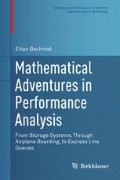Abstract
We consider the problem of configuring a mirrored storage system in a way which optimizes the concurrency of reading data. The problem is translated into the problem of constructing families of regular graphs with few cycles of any given size. We compute a lower bound on the number of possible cycle. We then show two constructions, one explicit coming from number theory and the other randomized which achieve the bound and hence are optimal.
Access this chapter
Tax calculation will be finalised at checkout
Purchases are for personal use only
References
Alon, N., Bachmat, E.: Regular graphs whose subgraphs tend to be acyclic. Random Struct. Algorithm 29(3), 324–337 (2006)
Alon, N., Milman, V.D.: λ 1, isoperimetric inequalities for graphs, and superconcentrators. J. Combin. Theory Ser. B 38(1), 73–88 (1985)
Alon, N., Spencer, J.H.: The Probabilistic Method. Wiley-Interscience Series in Discrete Mathematics and Optimization, 2nd edn. Wiley-Interscience, New York (2000) [With an appendix on the life and work of Paul Erdős]
Alon, N., Benjamini, I., Stacey, A.: Percolation on finite graphs and isoperimetric inequalities. Ann. Probab. 32(3A), 1727–1745 (2004)
Balaban, A.T.: A trivalent graph of girth ten. J. Combin. Theory Ser. B 12, 1–5 (1972)
Benson, C.T.: Minimal regular graphs of girths eight and twelve. Canad. J. Math. 18, 1091–1094 (1966)
Biggs, N.: Constructions for cubic graphs with large girth. Electron. J. Combin. 5(Article 1), 25 (electronic) (1998)
Bollobás, B.: Extremal Graph Theory, London Mathematical Society Monographs, vol. 11. Academic [Harcourt Brace Jovanovich Publishers], London (1978)
Bollobás, B.: A probabilistic proof of an asymptotic formula for the number of labelled regular graphs. Eur. J. Combin. 1(4), 311–316 (1980)
Bollobás, B.: Random Graphs, Cambridge Studies in Advanced Mathematics, 2nd edn., vol. 73. Cambridge University Press, Cambridge (2001)
Cain, J.A., Sanders, P., Wormald, N.: The random graph threshold for k-orientability and a fast algorithm for optimal multiple-choice allocation. In: Proceedings of the Eighteenth Annual ACM-SIAM Symposium on Discrete Algorithms, pp. 469–476, ACM, New York (2007)
Davenport, H.: Multiplicative Number Theory, Graduate Texts in Mathematics, 2nd edn., vol. 74, Revised by Hugh L. Montgomery. Springer, New York (1980)
Davidoff, G., Sarnak, P., Valette, A.: Elementary Number Theory, Group Theory, and Ramanujan Graphs, London Mathematical Society Student Texts, vol. 55. Cambridge University Press, Cambridge (2003)
Dickson, L.E.: Arithmetic of quaternions. Proc. London Math. Soc. S2-20(1), 225 (1921)
Dietzfelbinger, M., Goerdt, A., Mitzenmacher, M., Montanari, A., Pagh, R., Rink, M.: Tight thresholds for Cuckoo Hashing via XORSAT, 2009. In: Proceedings of International Colloquium on Automata, Languages and Programming, ICALP, Bordeaux, France, arxiv.org/ abs/0912.0287 (2010)
Dirichlet, P.: Beweis des Satzes, dass jede unbegrenzte arithmetische Progression, deren erstes Glied und Differenz ganze Zahlen ohne gemeinschaftlichen Factor sind, unendlich viele Primzahlen enthält. Abhand. Ak. Wiss. Berlin, 48 (1837)
Dodziuk, J.: Difference equations, isoperimetric inequality and transience of certain random walks. Trans. Am. Math. Soc. 284(2), 787–794 (1984)
Erdős, P., Rényi, A.: On random graphs. I. Publ. Math. Debrecen 6, 290–297 (1959)
Gerritzen, L., van der Put, M.: Schottky Groups and Mumford Curves, Lecture Notes in Mathematics, vol. 817. Springer, Berlin (1980)
Hardy, G.H., Wright, E.M.: An introduction to the theory of numbers, 5th edn. The Clarendon Press Oxford University Press, New York (1979)
Harris, Th.E.: The Theory of Branching Processes (Die Grundlehren der Mathematischen Wissenschaften, Band 119). Springer, Berlin (1963)
Hoory, Sh., Linial, N., Wigderson, A.: Expander graphs and their applications. Bull. Am. Math. Soc. (N.S.) 43(4), 439–561 (electronic) (2006)
Janson, S., Łuczak, T., Rucinski, A.: Random Graphs, Wiley-Interscience Series in Discrete Mathematics and Optimization. Wiley-Interscience, New York (2000)
Kolmogorov, A.N., Barzdin, Y.M.: On the realization of nets in 3-dimensional space. In: Selected Works of A.N. Kolmogorov, vol. 3, pp. 194–202. Kluwer Academic Publishers, Dordrecht (1993)
Lubotzky, A.: Discrete Groups, Expanding Graphs and Invariant Measures. Modern Birkhäuser Classics, Birkhäuser Verlag, Basel (2010) [With an appendix by Jonathan D. Rogawski, Reprint of the 1994 edition]
Lubotzky, A., Phillips, R., Sarnak, P.: Ramanujan graphs. Combinatorica 8(3), 261–277 (1988)
Marcus, A., Spielman, D.A., Srivastava, N.: Interlacing families I: bipartite Ramanujan graphs of all degrees, arXiv:1304.4132 To appear in Annals of Mathematics
Margulis, G.A.: Explicit constructions of expanders. Problemy Peredači Informacii 9(4), 71–80 (1973)
Margulis, G.A.: Explicit group-theoretic constructions of combinatorial schemes and their applications in the construction of expanders and concentrators. Problemy Peredachi Informatsii 24(1), 51–60 (1988)
Morgenstern, M.: Existence and explicit constructions of q + 1 regular Ramanujan graphs for every prime power q. J. Combin. Theory Ser. B 62(1), 44–62 (1994)
O’Keefe, M., Wong, P.K.: A smallest graph of girth 10 and valency 3. J. Combin. Theory Ser. B 29(1), 91–105 (1980)
Pinsker, M.S.: On the complexity of a concentrator. In: Proceedings of 7th International Teletraffic Conference, Stockholm (1973)
Sanders, P., Egner, S., Korst, J.: Fast concurrent access to parallel disks. Algorithmica 35(1), 21–55 (2003)
Sarnak, P.: Some applications of Modular Forms, Cambridge Tracts in Mathematics, vol. 99. Cambridge University Press, Cambridge (1990)
Serre, J.-P.: A Course in Arithmetic (Translated from the French, Graduate Texts in Mathematics, No. 7). Springer, New York (1973)
Tillich, J.-P., Zémor, G.: Optimal cycle codes constructed from Ramanujan graphs. SIAM J. Discrete Math. 10(3), 447–459 (1997)
Author information
Authors and Affiliations
Rights and permissions
Copyright information
© 2014 Springer International Publishing Switzerland
About this chapter
Cite this chapter
Bachmat, E. (2014). Mirrored Configurations. In: Mathematical Adventures in Performance Analysis. Modeling and Simulation in Science, Engineering and Technology. Birkhäuser, Cham. https://doi.org/10.1007/978-3-319-09513-4_4
Download citation
DOI: https://doi.org/10.1007/978-3-319-09513-4_4
Published:
Publisher Name: Birkhäuser, Cham
Print ISBN: 978-3-319-09512-7
Online ISBN: 978-3-319-09513-4
eBook Packages: Mathematics and StatisticsMathematics and Statistics (R0)

